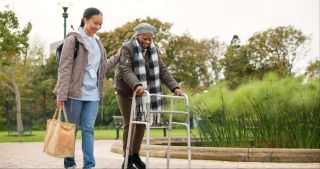Caregiving
Caregiving Safety and Autonomy
Helping your loved one live with dignity at every caregiving stage.
Posted April 11, 2024 Reviewed by Ray Parker
Key points
- It can be hard to balance safety and autonomy with your loved one.
- You may prioritize safety while they prioritize autonomy.
- Focusing on ways to ensure dignity through the many changes that may come is a helpful approach.

There is a thin line between safety and autonomy. I heard some version of that statement at the outset of my caregiving journey.
When you’re taking care of someone you love, it’s hard to resist the urge to prevent absolutely all possible harm. The problem is that to achieve absolute safety, you’ll need to swaddle them in bubble wrap.
The cost of zero risk? Loss of autonomy and all that goes with it.
Somewhere along that spectrum—from total safety to complete autonomy—a caregiver has an opportunity to help preserve dignity during a time of change and loss.
What You Can Do
If your person has been independent, mobile, and relatively healthy until now, it would be rather unusual for them to request assistance using the hospital bathroom or bedside commode, let alone in the home.
You’ll want to do everything you can to maintain that privacy. Maybe it’s placing wet wipes in the bathroom in addition to toilet paper, which doesn’t clean as well (or installing a bidet). Maybe it’s a walker with a seat that helps your loved one transfer to the bathroom.
Maybe a time will come when you need to introduce and encourage the wearing of incontinence briefs discreetly. Your loved one may not ask for these, but they may also quietly thank you in their head for making it happen when it’s clear that something needs to change. Place them where they normally keep their underwear and put some in the bathroom as well.
Bathing may become progressively more difficult in terms of getting into and out of the bathtub or shower staff, handling bars of soap, cleaning hard-to-reach places, and avoiding falls. Don’t wait for something dramatic to occur before you make modifications. A handrail inside the tub, on the walls, and next to the toilet.
Unless you have a walk-in tub, which can provide great convenience for your person, a bath chair at the least is necessary, and even better, a transfer chair for ease of moving into and out of the shower or tub. Also, a sponge that's attached to a long handle and a no-slip bath mat.
Your loved one may be more accepting of bodily changes than others, in which case they might ask about and request these items. However, if you make improvements that make daily toileting and bathing rituals easier and even more pleasant, they will likely say nothing and not argue.
As Things Progress
Despite these efforts, there may come a time when your person simply cannot do it alone, regardless of how much you’ve adapted home devices. They may need help cleaning themselves after a bowel movement; otherwise there is a risk of skin breaking down in their backside, which is a recipe for an infection and worse.
They may need assistance or at least supervision transferring into the shower or bath. They may be grateful for help managing all the details in the shower: the soap, the washcloth, the sponge, reaching parts of their back. Everything we took for granted for decades.
At some point, a physician may recommend that a professional walk through your loved one’s home to identify safety risks and propose solutions. That visit may be covered by some form of health care insurance. Until then, you are among the best positioned to scan their environment with similar goals. As you walk through their home, here are some guiding questions for each room.
A Checklist for Dignity
Bathroom
- How do they sit on the toilet? How do they stand? Are there support handrails?
- How are the toilet paper, wipes (and trash can), or bidet placed?
- How do they bathe? If standing, do they risk slipping on the floor?
- If sitting in the tub or shower, is there a transfer bench to move them in and out?
- Are bathing supplies within arm’s reach when they are seated?
- Do they have adaptive tools for bathing to clean hard to reach places?
Living Room
- How does your person stand from their favorite chair or sofa? Are there handrails to assist in maintaining independence?
- If your loved one is hard of hearing, would they benefit from a Bluetooth speaker near them? (Or perhaps anyone else in the household would benefit from it so the television isn’t blaring.)
- Are there floors clear of clutter so your person can easily walk with support devices such as a cane or walker?
- If your loved one uses oxygen, is there a system for moving about the home while still connected to the oxygen tank or concentrator?
Kitchen
- If your loved one experiences incontinence, are there incontinence pads available to protect chairs?
- Are your person’s medication bottles stored in a central location?
- Are your loved one’s medications sorted into pill boxes and/or another container for alcohol swabs, lancets, and injections?
- Do any of your person’s medications require refrigeration? If so, are they clearly marked and kept together?
- Do any of your loved one’s medications require special handling, such as gloves for oral chemotherapy?
- Does your person keep a calendar of appointments and related preparation posted in clear view, or do they have another equivalent system?
Bedroom
- Some of the same questions apply, such as clutter on the floor.
- Does your person have sufficient lighting, such as nightlights, to reach the bathroom in the middle of the night?
- If your loved one experiences incontinence, are there washable and/or disposable incontinence pads on the bed?
- For the sake of caregivers, are there sufficient sets of sheets, blankets, and incontinence pads if multiple changes are needed each night?
- Would a bedside commode and/or urinal make sense for your loved one?
General
- Clear floors
- Steps, railings
Have in stock
- Incontinence briefs
- Incontinence pads
- Extra bedding
- Carpet cleaner
- Easy meals
- Favorite snacks
- Bottles of Ensure or other meal supplement
- Games and other entertainment
As you take this journey alongside your loved one, it may be emotionally difficult—not to mention logistically and physically. At the end of the day, you will know that you’ve done your best to find a balance between safety and autonomy.
Now drink a glass of water and get some rest.




